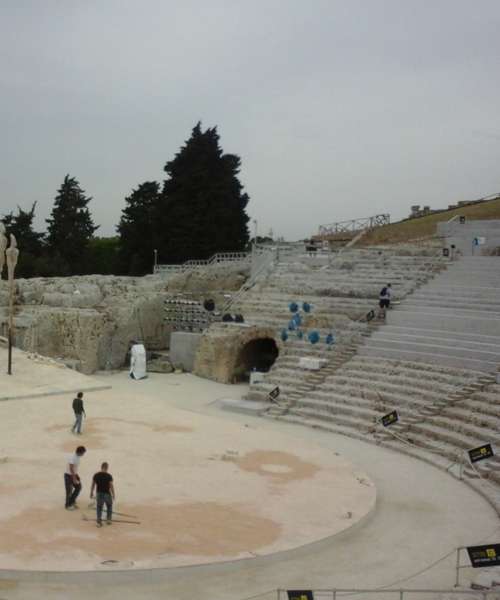Home - In and around
THE GREEK THEATER OF SIRACUSA
The theater is certainly one of the most famous in the ancient world: travelers and landscape painters from the '700 and the' 800 left many descriptions and views.
The monument has been the subject of numerous studies that have not only examined it but deepened the origins and evolution of Greek theater as an architectural creation. Numerous sources tell us about a Greek theater in Syracuse, the work of the architect Damocopo called Mirylla.
Of the theater is preserved the part excavated in the rock, while the built part of the cavea as well as the monumental remains of the Roman age scene are lost, perhaps due to the reuse of the blocks and by the Spaniards that they would serve to realize the fortifications of Ortigia between 1520 and 1531.
Archaeological investigations that began between the end of the 18th and the early 1800s have continued on several occasions, and studies and research are still ongoing. The theater carved in the rock of the Temenite Hill presents a very large cave, with 67 steps of steps; divided into nine wedges by eight steps and horizontally, halfway around, from a corridor (diasoma). The wall upstream of this diazoma, characterized by the presence of moldings, engraved with inscriptions in Greek. From the first wedge to the West are the names of: Gelone II (perhaps), son of Ierone II and his predecessor, of his wife Nereide, of Filistide, wife of Ierone II, and of Ierone II. At the W Wedge there are some letters that allow you to return "Zeus Olimpio"; It also seems to follow the name of Heracles. The names of other gods are no longer readable.
The construction technique, the size of the form of the cave and the orchestra and even the inscriptions now described have suggested to some scholars to erect the monument between 238 and 215 BC. The upper part of the cavea, built from the 19 th step above the diazome, was bordered by a wall that provided support for the artificial embankment. Both the orchestra and the scene area have traces of subsequent modifications, transformations linked to both the different requirements of the technical apparatus and the use of theater over the centuries. The different tracks on the rock have been interpreted differently, resulting in different readings of the various phases of the monument itself.
Some scholars (Anti, Polish) have seen the traces of a first linear and then trapezoidal shape which only in the timolene age would have assumed a semicircular shape. Others think that it has been semi-circular since its origins and that trapezoidal cutting should be considered as the late-stage result of the transformation of the theater to place for shows and water games. The last plays on the theater seem to be able to refer back to the beginning of the fifth century. d.C., on the basis of an inscription, now lost, which remembers an intervention on the scene by Nerazio Palmato.
At the top of the cavea, in the western sector, was a "L" porch. A quay, cut into the rock, is visible, referring to the foundation of the colonnade frontal. There are visible edges of cobblestone flooring and beam holes. At the center of the rocky part is a large artificial cave featuring a vaulted ceiling and a rectangular tub with a cocciopesto coating that collects the water that flows from a niche to the bottom. This conduct is a branch of the "nympho" aqueduct of the Greek age, while the other conduit which even reached the nymphs was part of the aqueduct Galermi.
Outside, the cave is characterized by the presence of 4 niches; two, smaller, originally plastered and two larger, placed externally over the first and the lower. It is very likely that they originally hosted statues and that they were later transformed into burials. The wall where the cave opens is superbly decorated by a Doric frieze of which traces remain. This arrangement is thought to be before the creation of the porch.
source regional site cultural assets
The monument has been the subject of numerous studies that have not only examined it but deepened the origins and evolution of Greek theater as an architectural creation. Numerous sources tell us about a Greek theater in Syracuse, the work of the architect Damocopo called Mirylla.
Of the theater is preserved the part excavated in the rock, while the built part of the cavea as well as the monumental remains of the Roman age scene are lost, perhaps due to the reuse of the blocks and by the Spaniards that they would serve to realize the fortifications of Ortigia between 1520 and 1531.
Archaeological investigations that began between the end of the 18th and the early 1800s have continued on several occasions, and studies and research are still ongoing. The theater carved in the rock of the Temenite Hill presents a very large cave, with 67 steps of steps; divided into nine wedges by eight steps and horizontally, halfway around, from a corridor (diasoma). The wall upstream of this diazoma, characterized by the presence of moldings, engraved with inscriptions in Greek. From the first wedge to the West are the names of: Gelone II (perhaps), son of Ierone II and his predecessor, of his wife Nereide, of Filistide, wife of Ierone II, and of Ierone II. At the W Wedge there are some letters that allow you to return "Zeus Olimpio"; It also seems to follow the name of Heracles. The names of other gods are no longer readable.
The construction technique, the size of the form of the cave and the orchestra and even the inscriptions now described have suggested to some scholars to erect the monument between 238 and 215 BC. The upper part of the cavea, built from the 19 th step above the diazome, was bordered by a wall that provided support for the artificial embankment. Both the orchestra and the scene area have traces of subsequent modifications, transformations linked to both the different requirements of the technical apparatus and the use of theater over the centuries. The different tracks on the rock have been interpreted differently, resulting in different readings of the various phases of the monument itself.
Some scholars (Anti, Polish) have seen the traces of a first linear and then trapezoidal shape which only in the timolene age would have assumed a semicircular shape. Others think that it has been semi-circular since its origins and that trapezoidal cutting should be considered as the late-stage result of the transformation of the theater to place for shows and water games. The last plays on the theater seem to be able to refer back to the beginning of the fifth century. d.C., on the basis of an inscription, now lost, which remembers an intervention on the scene by Nerazio Palmato.
At the top of the cavea, in the western sector, was a "L" porch. A quay, cut into the rock, is visible, referring to the foundation of the colonnade frontal. There are visible edges of cobblestone flooring and beam holes. At the center of the rocky part is a large artificial cave featuring a vaulted ceiling and a rectangular tub with a cocciopesto coating that collects the water that flows from a niche to the bottom. This conduct is a branch of the "nympho" aqueduct of the Greek age, while the other conduit which even reached the nymphs was part of the aqueduct Galermi.
Outside, the cave is characterized by the presence of 4 niches; two, smaller, originally plastered and two larger, placed externally over the first and the lower. It is very likely that they originally hosted statues and that they were later transformed into burials. The wall where the cave opens is superbly decorated by a Doric frieze of which traces remain. This arrangement is thought to be before the creation of the porch.
source regional site cultural assets



